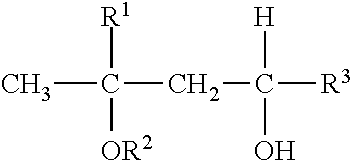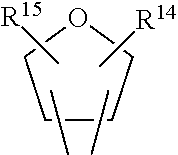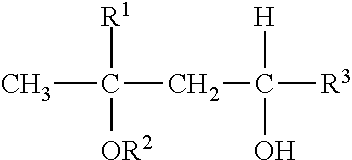Photoresist and post etch residue cleaning solution
a technology of photoresist and residue, applied in the field of cleaning solution, can solve the problems of methylpyrrolidone (, inability to achieve complete removal of many dry-film resists, compatibility problems with photoresists, etc., and achieve the effect of effective simultaneously cleaning
- Summary
- Abstract
- Description
- Claims
- Application Information
AI Technical Summary
Benefits of technology
Problems solved by technology
Method used
Image
Examples
example 1
[0120]The components for the formulations tested, [1-8] in the following Examples were combined with stirring at room temperature to give between 100 and 300 g of a homogenous stripper solution. Solution homogeneity requires the KOH to be blended into the appropriate co-solvents prior to addition of DMSO. The surfactant is added into the blend last. The solution was heated to 93° C., with slow agitation for 2 hours. The timer was started when the solution reached the desired temperature. The solution was then removed from the heat source and left to cool to room temperature, 23° C. Observations about solution clarity and amount of precipitate were recorded in Table 2.
example 2
[0121]The components for the formulations tested in the following Examples were combined with stirring at room temperature to give between 100 and 300 g of a homogenous stripper solution. Solution homogeneity requires the KOH to be blended into the appropriate co-solvents prior to addition of DMSO. The surfactant is added into the blend last. The solution was heated to between 93° C., with slow agitation. Patterned test wafers with solder bumps positioned as an array in a polyimide film were obtained. The test wafers had been processed in a high energy oxidizing plasma to remove about 1-3 μm of polyimide. Residues deposited on the sides and tops of solder bumps during a plasma process were not removed prior to these tests. The patterned test wafers were cleaved into ˜4×3 cm pieces and mounted into a small scale wafer holder.
[0122]Unless otherwise noted in a Table, each stripper solution was heated to 93° C. and a wafer piece immersed. The timer was started as soon as they were fully...
example 3
[0125]The components for the formulations tested, [9-25] in the following Examples were combined with stirring at room temperature to give between 300 g of a homogenous stripper solution. Solution homogeneity requires the KOH to be blended into the appropriate co-solvents prior to addition of DMSO. The surfactant is added into the blend last. The solution was heated to 93° C., with slow agitation for 2 hours. 93° C. was selected as an extreme temperature to exacerbate any stability problems that could occur. The timer was started when the solution reached the desired temperature. The solution was then removed from the heat source and left to cool to room temperature, 23° C. Observations about solution clarity and amount of precipitate were recorded in Table 3.
PUM
| Property | Measurement | Unit |
|---|---|---|
| flash point | aaaaa | aaaaa |
| flash point | aaaaa | aaaaa |
| flash point | aaaaa | aaaaa |
Abstract
Description
Claims
Application Information
 Login to View More
Login to View More - R&D
- Intellectual Property
- Life Sciences
- Materials
- Tech Scout
- Unparalleled Data Quality
- Higher Quality Content
- 60% Fewer Hallucinations
Browse by: Latest US Patents, China's latest patents, Technical Efficacy Thesaurus, Application Domain, Technology Topic, Popular Technical Reports.
© 2025 PatSnap. All rights reserved.Legal|Privacy policy|Modern Slavery Act Transparency Statement|Sitemap|About US| Contact US: help@patsnap.com



